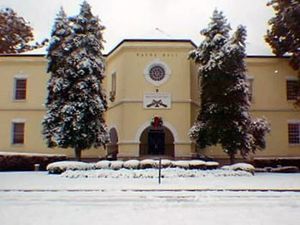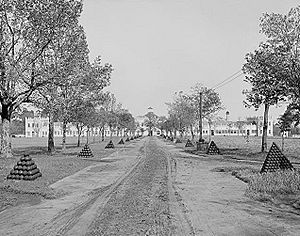Augusta Arsenal facts for kids
Quick facts for kids Augusta Arsenal |
|
|---|---|

The Augusta Arsenal's original Headquarters Building, dating back to 1827–29. Now Payne Hall at Augusta University.
|
|
| Location | Augusta, Georgia |
| Founded | 1816 |
| Built | 1827–29 |
| Built for | Government of the United States |
| Governing body | State of Georgia |
The Augusta Arsenal was an important military base in Augusta, Georgia, during the 1800s. It was first built in 1816 on the Savannah River. However, because of health concerns, it was moved in 1827. The new location was the former Belle Vue estate in the Summerville area of Augusta.
A New Home for the Arsenal
The Belle Vue estate was once owned by George and Eliza Talbot Walker. Their granddaughter, Octavia Walton Le Vert, was born there in 1811. George later sold the estate to his brother, Freeman Walker.
In 1826, Freeman Walker sold most of the property to the United States government. He sold 72 acres for $6,000. He kept one acre for the Walker Family Cemetery. The arsenal moved to this new spot in 1827. Four large brick buildings were finished in 1829. These buildings were connected by a thick wall.
Soldiers from the arsenal took part in different military actions. This included conflicts with Native American tribes like the Cherokee, Muscogee, and Seminole. They also fought in the Mexican–American War.
The Civil War Years
In 1861, Georgia decided to leave the United States. This was called secession. On January 23, 1861, Georgia's governor, Joseph E. Brown, visited the arsenal. He told the commander, Arnold Elzey, to give the base to the state. Elzey first said no.
About 600 people in Augusta then joined the local militia. They heard the state might take the arsenal by force. Governor Brown gave Elzey another chance to surrender. Elzey told his leaders what was happening. The next day, he handed the arsenal over to Georgia.
By summer 1861, the Confederate army wanted to make the arsenal much bigger. Their plan was to build a "great arsenal of construction." This meant they would make lots of ammunition and other war supplies there. In April 1862, Lieutenant Colonel George Washington Rains took charge of the arsenal. He also built the huge Confederate Powderworks nearby.
The arsenal made many war supplies from 1863 to 1865. In November 1864, the arsenal was in danger. This was during Sherman's March to the Sea. Equipment was ready to be moved. But the Union Army turned towards Savannah instead. The arsenal was given back to the U.S. government on May 3, 1865.
Today, the Augusta Arsenal still has three Confederate cannons. Two are displayed at Payne Hall, the original headquarters. A third is outside the old guardhouse. The guardhouse was built in 1866. In 2004, it became a small museum. It shows artifacts and photos found during digs. The military cemetery next to it holds the graves of 48 soldiers, 12 women, and 10 children. Some graves are unknown. They date back to 1841.
Later Years and New Purpose
The arsenal was very important during the Spanish–American War. It made different types of equipment. It also served as a place to get supplies and fix things. During World War I, the arsenal fixed small arms. After World War I, fewer people worked there.
But during World War II, activity grew a lot. About 50 new buildings were constructed. The main jobs were maintaining and supplying weapons and ammunition. Over 1,000 people worked at the arsenal then.
The arsenal stayed open until 1955. Then, it was decided to close it. Most of the property was given to the Georgia Board of Education. In 1957, it became the Junior College of Augusta. The name changed to Augusta College in 1958. Later, it became Augusta State University. In 2012, it merged with another school to become Georgia Regents University. After many people complained, it was renamed Augusta University in 2015.
The arsenal commandant's house is one of the original buildings. It is now called the Stephen Vincent Benét House. It was named a National Historic Landmark in 1971. The famous poet and novelist Stephen Vincent Benét lived there. His father, Colonel James Walker Benét, commanded the arsenal from 1911 to 1919. The house later became the President's House for Augusta College.
Images for kids



